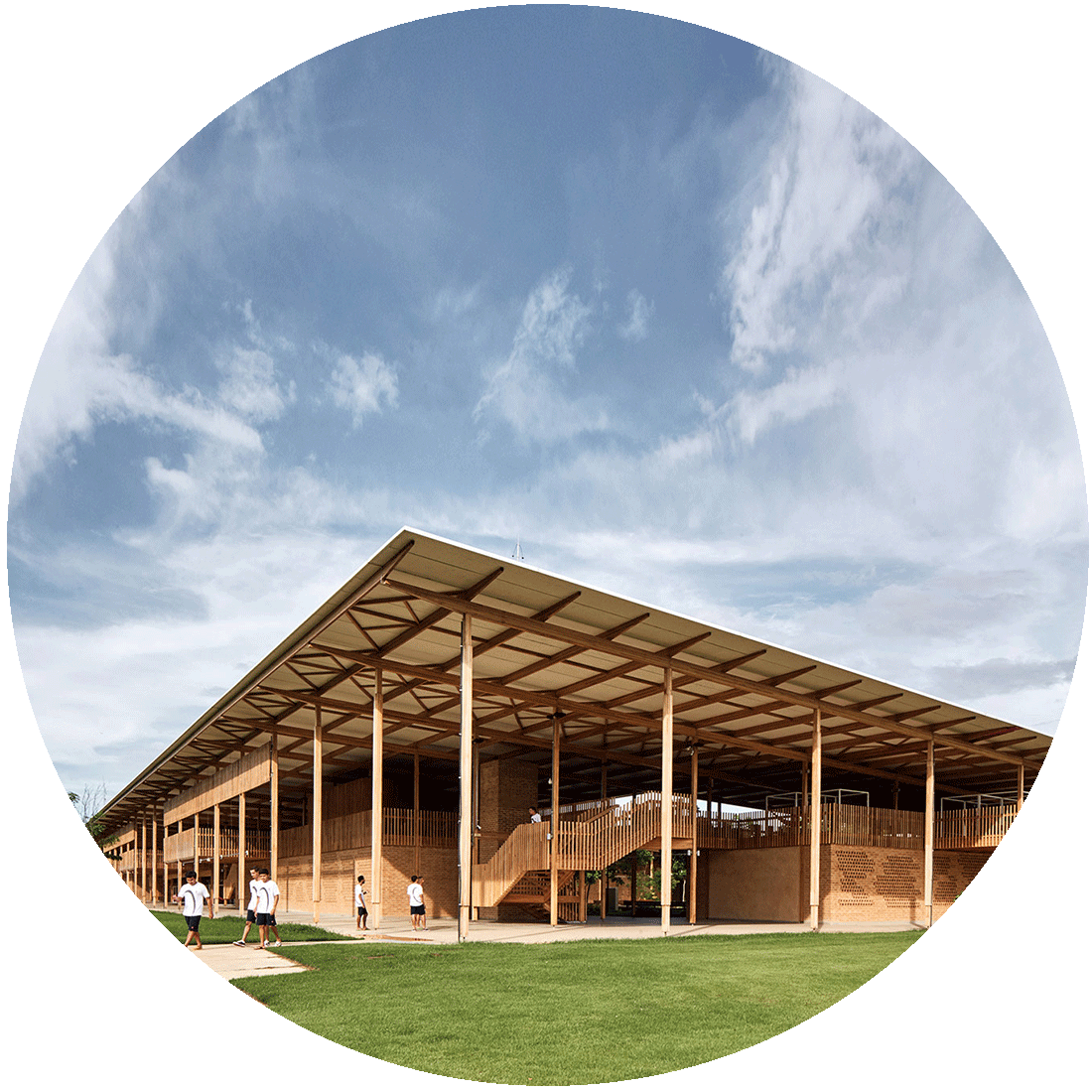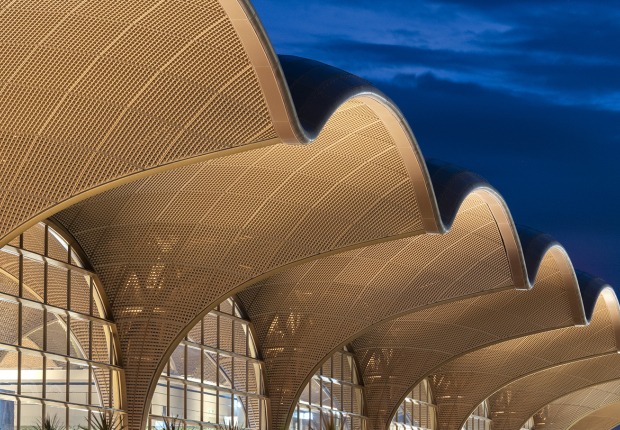Siedhoff-Buscher developed research into children's pedagogy and designed furniture and toys for children, the most significant of her projects being the "nursery" of the model house "Haus am Horn" in 1923. While van Eyck reclaimed urban spaces after the war with "playgrounds" that nurtured children's imagination and gave them a space in the city.
In this article we have compiled 12 children's architecture projects that use strategies that take children into account and adapt to their needs, awakening their curiosity and interacting with them in a pedagogical but fun way. This article presents projects by the following architects and studios: MGM Arquitectos, El equipo Mazzanti, ARX Portugal, C Cúbica Arquitectos, Rosenbaum + Aleph Zero, AAVP, Wutopia Lab, COBE, and WAO.
1. Integrating the sense of community. Nursey School BVMI by MGM Arquitectos

The project by MGM Arquitectos, located in Seville, focuses on building a nursery school, reforming the pathologies of the existing classrooms, and creating an area of access and separation from the existing school.
MGM Arquitectos defines a functional program of several classrooms organized around a eucalyptus tree, where all the classrooms face each other and create an outdoor play area. In addition, the classrooms have doors with access to the playground creating a labyrinth structure, with the pedagogical intention of relating knowledge, research, participation, and strategy planning, individually and/or collectively.
The structure has been a fundamental element in the configuration of the project, it has been designed as play furniture in itself, which at the same time provides a great unity to the whole of the roof.
2. A learning and playing building itself. Renovation and extension of the Helvetia School by El equipo Mazzanti

El equipo Mazzanti has designed the refurbishment and extension of the Helvetia School, considered an Asset of National Cultural Interest, which was founded in 1954 by the Swiss community in Bogotá.
The premise of El equipo Mazzanti is to respond to new forms of teaching, designing a playful learning device, where the architecture serves as a third teacher, while at the same time seeking to be respectful of the original building. To this end, they create an English courtyard by sinking one level and organize the project into two wings, a smaller one for primary school and a longer one for secondary school.
The project is a spatial instrument based on discontinuity and the appearance of meeting subspaces, seeking the greatest spatial diversity that will awaken the children's curiosity and invite them to discover their emotions, opening windows for learning and stimulating the processes of cognitive bodily development, using the empty space as an instrument for play.
3. Modules and patterns of association in educational architecture. 21 Atlántico Kindergartens by El Equipo Mazzanti

In the project 21 preschools in Atlántico, El Equipo Mazzanti develops a design proposal for twenty-one projects in different urban and semi-urban locations in the northern city of Atlántico, in Colombia. In this project, the architecture hopes to become a prototype of educational needs coverage, social change, inclusion, and urban revitalization, through the use of public space as a community meeting point and a point of reference for the people.
As the main objective, El equipo Mazzanti proposes an educational architecture designed like an organism capable of changing and adapting to new forms of teaching, as well as to the relationships between students, their families, and the community.
El equipo Mazzanti implements open and adaptive systems, through modules that adjust their constructive strategy according to the conditions of each of the kindergartens, adapting to different topographical, urban, social, or programmatic situations. In this way, it manages to develop buildings that relate to the geography and topography where they are inserted.
4. Educational park of Marinilla by El Equipo Mazzanti

The Marinilla Educational Park is designed by El Equipo de Mazzanti as a meeting place around learning as a natural habit of knowledge construction, through dialogue and exchange between its visitors, the built environment, and the surrounding natural landscape.
The aim of El Equipo Mazzanti is for the Marinilla Educational Park to be more than a building, and to become a public space in itself. To achieve this, they propose a building of permeable materiality, with prefabricated panels of expanded mesh, transforming the building into a semi-open space, in constant contact with the exterior.
In addition, with this project, El equipo Mazzanti seeks to make known, promote and preserve the cultural identity of the Paisa community. The building is conceived as a network of unfinished spaces, with the capacity to connect to similar pieces and thus expand its impact on an urban level.
5. Two opposite building typologies. Redbridge School in Lisbon by ARX Portugal

Redbridge is a new international school located in the heart of Lisbon. In this project ARX Portugal had an ambitious challenge, both in terms of the location of the site and the pedagogical aspect, to create an innovative school with a human approach, promoting creativity, the joy of learning, and openness to international multilingual exchange.
ARX Portugal proposes two opposing building typologies and unifies them through a wooden structural system. To the north, it proposes the main building, an urban and longitudinal four-story building that houses the school's main program.
To the south, it proposes a low pavilion that houses kindergarten classrooms and a small administrative and teachers' space. The organic form of this pavilion seeks to define an environment of symbiosis between the building and nature, through its concave facades resulting from the location of existing trees and a set of proposed new trees.
6. Tuxtla Gutiérrez Children's Museum by C Cúbica Arquitectos

The Tuxtla Gutiérrez Children's Museum is a sustainable project with great social impact, designed by C Cúbica Arquitectos, and its unique architecture is based on the reinterpretation of the orography of the state of Chiapas, where it is located.
The Tuxtla Gutiérrez Children's Museum aims to promote values in Chiapas children through educational activities that encourage respect for the natural and cultural biodiversity of the state, seeking to create a meaningful learning experience.
C Cúbica Arquitectos reduced costs in all aspects of the building, making efficient use of national materials. In addition, aspects of sustainable architecture were taken into account to reduce the building's energy consumption.
7. RIBA International Emerging Architect for Children Village by Aleph Zero

The Children's Housing - Fundação Bradesco, designed by Rosenbaum + Aleph Zero, is a residential project that complements an educational program, located in the vastness of the Brazilian tropical savannah, in Formoso do Araguaia, Brazil. The project is inspired by the place, the indigenous beauty, and their knowledge, seeking to rescue the local culture.
Rosenbaum + Aleph Zero proposes an organization in villages for the new residence, based on the need to add value to the existing complex and encourage a sense of belonging for the students of the Canuanã school. The architects' design, together with the students, a series of interactive complementary programs to improve the quality of life and strengthen the bond between the students and the school, thus demystifying the school as a single learning space and adding a layer of homelike value to it.
The proposed new villages aim to increase children's self-esteem through the use of local techniques, creating a bridge between vernacular techniques and a new model of sustainable housing.
8. Design of a new Elementary School in France by Vincent Parreira

The Louis de Vion school complex, designed by AAVP, is located in a vague setting in Montévrain, Paris. AAVP organizes the complex as a small miniature city, a school village.
The exterior void pushes the project towards the proposed interior squares, where transparencies and courtyards are implemented to organize the educational program. Once the child crosses the threshold of this school complex, he or she enters a different world, evoking, with its materiality, troglodyte houses, vernacular architecture, the complex becomes a place of play and refuge for children.
In the Louis de Vion school complex, AAVP aimed to encourage and develop children's curiosity through architecture, and a first encounter with the mysteries of the world.
9. Lolly Laputan Fairyland Kids Premium Kids Café by Wutopia Lab

Fairyland Premium Kids Café, designed by Wutopia Lab, is the first educational family restaurant in China, the client wanted children to be able to enjoy learning and be entertained at the same time.
Wutopia Lab was inspired by a drawing of a "fairyland dream" by one of the daughters of a team member. Through this educational café for children, Wutopia Lab wanted to make fairyland a reality, allowing more children to enjoy this dream come true.
The Cloudy Town forms the central space of the children's wonderland. In this space, they can enjoy the Ocean of Clouds made of acrylic, with treehouses, slides, and a ball pool, alternating with dining rooms and lounges immersed in a fantasy aesthetic, which manages to entertain both children and adults.
10. Polycarbonate Neverland. Aranya Kid's Restaurant by Wutopia Lab

Wutopia Lab designs 'Neverland', a restaurant for children that arises from the renovation of a part of the Aranya clubhouse in China.
Wutopia Lab proposes the use of translucent materials in combination with diffuse lighting, creating an experience in which the sense of texture, scale, and direction is lost in this space. The children's restaurant becomes a polycarbonate Neverland, the original façade is wrapped in polycarbonate panels, blending prairie village style with contemporary Art Deco, creating a new translucent façade.
At the edge of the main space, there are baths of different colors and sounds, a pool mirror, a stainless steel slide, a trampoline, a bubble tree, and a mysterious picture book area, these spaces are a series of hidden corners in this "unknown land" that Wutopia Lab hopes children will discover for themselves.
11. Kindergarten by COBE

The Danish studio COBE designed an integrated kindergarten in a historic area of Copenhagen, Denmark. The garden consists of five small units, up to three stories high, unified constructively by vertical louvered facades and green roofs.
From the outside, the kindergarten looks like a small city for children, inside, it is coherent and efficient. COBE creates a small, compact and exciting space for children, which is at the same time functional and flexible in its everyday use.
"With this project, we wanted to create a world class day care center. A place that gives the best possible environment for our children to grow up in, and which promotes children’s learning and creativity. Located in a historic area of Copenhagen consisting mainly of nursing homes and senior housing, we have been very aware of ensuring a coherence between the historical area and the new build. From being a last destination for many people’s long lives, the area is now also a place where children grow up and start their lives"
12. Jumping on water. LILY by WAO

WAO has designed LILY, a floating structure in Poitiers, France. In LILY, WAO proposes an alternative and flexible architecture that offers a playful and sensorial experience, temporarily transforming the central lake of Futuroscope into a children's playground.
The LILY complex is made up of five giant buoys, which house trampolines, fun places for jumping or lounging in the sun. They are moored to a deck on which one can walk, contemplating the large white volumes in their relationship with the water.
In this installation, WAO combines manufacturing with technological innovation, which allowed for a short production and assembly period.


































































